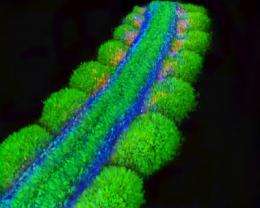Professor Christophe Marcelle and his team have deciphered how signals from neural crest cells (pictured in blue) regulate the development of the first muscle cells.
Research at the Australian Regenerative Medicine Institute (ARMI) at Monash University could lay the groundwork for new muscular dystrophy treatments.
A team led by developmental biologist Professor Christophe Marcelle has worked out how embryonic stem cells differentiate into specialist skeletal muscle cells early in development.
The work, published in the British journal Nature in May 2011, could point the way to regulating the differentiation of muscle stem cells into functional muscle fibers, leading to treatments for muscular dystrophy through cell therapy. Cell therapy involves implanting healthy or genetically engineered muscle cells into the patient.
“We wanted to find out the mechanism of cell fate – why some embryonic stem cells simply renew themselves while others undergo differentiation,” Professor Marcelle said.
“This is the main unresolved question in any stem cell field – to understand how you can affect the balance between self renewal and differentiation into tissue.”
Professor Marcelle says there is no cure for any of the muscle wasting disorders collectively known as muscular dystrophy.
Cell therapy could also be used to treat the debilitating muscle wasting of ageing at a time when Australia is grappling with the problems of its ageing population.
“More than 2 per cent of the population is affected by various muscle dysfunctions, including genetic diseases such as dystrophies or muscle weakness from aging,” Professor Marcelle says.
“Given the burden that muscle diseases impose on the economy, it is critical to develop innovative approaches and explore avenues of research that will lead to the discovery of new cures for muscle pathologies and muscle wasting.”
Provided by Monash University


















